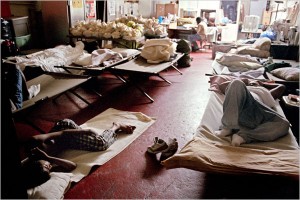Mar 23 2009
Homeless~Youth
![]() Welcome to Macaulay Eportfolio Collection.
Welcome to Macaulay Eportfolio Collection.
There are approximately 1.3 million homeless children on any given night in the U.S. according to the National Coalition for the Homeless in 2000. Youth ages 15-17 made up most (68%) of the runaway/throwaway population in 1999 according to the National Incidence Studies of Missing, Abducted, Runaway, and Throwaway Children (NISMART).

A homeless youth is defined as anyone who has spent at least one night literally homeless without parental supervision. By literally homeless we mean any place that is not intended to be a place of residence. This includes the streets, shelters, institutions, foster care, hospitals, etc. Homeless youths are generally between the ages of 13 to 21. Homeless youth includes but is not limited to runaways, who have left homes without permission; throwaways, who have been forced to leave by their parents or guardians, and institutional youth, who have extensive histories of staying in institutions such as foster care and group care.
Homelessness is defined as a condition in which a person does not have fixed and regular residence. A person is considered homeless if his/her nighttime residence includes public and private places that are designed as temporary living accommodations, which include motels and shelters.

There is no one reason for which a youth may be homeless, but many homeless youth report that they ran away from their home because of verbal, physical or sexual abuse. Families may also see their child as a burden due to financial reasons and may force their child to leave their homes. Some homeless youth may be thrown out of their homes due to their homosexuality, contracting HIV, getting pregnant or their failure to do well in school. Most runaway/throwaway episodes are preceded by familial conflict.
There are added dangers for youths who have taken to the streets without parental supervision, which includes engagement in risky behaviors. Homeless youth on the streets are more likely to have health and behavioral problems. Because many homeless youth trade sex for necessities such as food and shelter, homeless youth are more susceptible to getting HIV and other sexually transmitted diseases, and females are more likely to get pregnant. As mentioned before, these are the same reasons why many homeless youth get thrown out of their homes. Homeless youth on the streets are more likely to have psychological disorders and drug addictions. In many cases of homeless youth, it is more convenient that homeless youth reunite with their families.
Reunification of homeless youth with their family, whether within the nuclear or extended family, is very important and is an issue that should be confronted today. Homeless youth still do not have the skills to live on their own and they need a support network to help them. A long-term support network is needed for these youth that a family could provide. These homeless youth are still trying to figure out their identities and need a family to help them.
The Family and Youth Services Bureau, in the Department of Health and Human Services Administration for Children and Families, administers programs that help the homeless youth. The Basic Center Program provides assistance in the immediate needs of the homeless youth. The Transitional Living Program gives homeless youth ages 16-21 long-term residential services for 18 months. The Street Outreach Program helps homeless youth get off the streets.
The Covenant House is a privately funded organization that was first founded in New York City in 1972, and seeks to provide shelter and services to runaway and throwaway youth. It has wide reaching branches throughout the United States, Canada, Honduras, Mexico and Nicaragua. The agency provides a wide array of services to youth that consist of food, crisis care, shelter, medical care, educational and vocational programs, drug abuse treatment, transitional living programs and street outreach. The Covenant House aided more than 70,000 youth in 2008.

The National Coalition for the Homeless is another unique organization that strives to end homelessness. The coalition was founded in 1982, and is a network of activists, advocates, community-based and faith-based service providers, and people who have been or are currently homeless. It provides immediate services for the people and work at policy advocacy to achieve their mission.
These programs do satisfy the immediate needs of the homeless youth but they are limited and still do not give homeless youths what they really need: a stable home. Once a homeless youth is aged-out of foster care or reaches the age limit of a program, many of the homeless youth do not have a long-term support network to help them.





Hi, this is a comment.
To delete a comment, just log in, and view the posts’ comments, there you will have the option to edit or delete them.